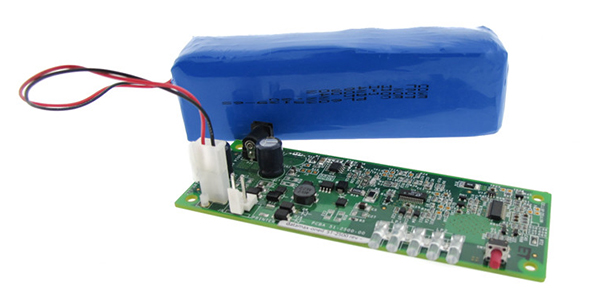In today's battery and charger market, most companies typically provide either battery pack assemblies or battery pack chargers, as opposed to providing both. In the past, buying a battery from one source and a charger from another worked just fine when using the older NiCd batteries with overnight chargers. However, due to new battery chemistries and the increasing need for faster charge times, careful matching of the charger to the battery has become essential. Without proper battery and charger matching, aspects such as safety, cycle life, and run-time may be greatly affected.
When fast-charging NiCd batteries at rates of 1C to 4C, safety can be an issue. In these high-current applications, battery temperature must be monitored electronically, so precise control of the charger can be obtained. Once the battery is fully charged, the high-charge rate must be reduced to prevent the battery from going into thermal runaway and venting.

Lithium Polymer Battery Pack and Custom Charger
Charger Impact on Battery Cycle Life
Cycle life can be negatively impacted when batteries from different manufacturers are charged in the same manner. Even the same types of batteries, such as Li-lon and NiMH, may require separate charging considerations. Inspection of the manufacturer's data sheet revealed that some types of NiMH batteries can take a continuous C/1O overcharge, whereas the most popular types of NiMH batteries cannot without severely affecting the cycle life of the battery. Precaution must be taken to understand the difference between the various manufacturers of Li-Ion batteries and how these differences affect the charging characteristics of their batteries. Some manufacturers require 4.1 V/cell charge voltage, while others require 4.15 or 4.2 V/cell charge. If these voltages are exceeded by as much as 50mV, the battery will overcharge, altering cycle life of the battery and causing safety issues.
Insufficient Battery Run Times
Insufficient run time is caused by undercharging the battery, which can happen by misapplying technology. For example, charging of a 4.2 V/cell Li-Ion battery using a 4.1 V/cell Li-Ion charger or by not fully characterizing the system dynamics. Some early termination problems can be caused by system noise by operating outside the temperature range of the battery or by using a mismatched thermistor in the battery pack. The only way to ensure the charger and battery are matched correctly is to buy the whole unit from one source that has the expertise in designing and providing fully custom battery assemblies and fully custom chargers to meet the requirements of the customer.
Sourcing Complete Battery Power Solutions
The "one stop shop" approach to custom battery packs and chargers is extremely beneficial to the person purchasing the batteries and chargers. If the battery pack and charger are ordered from two different sources, the customer will need to coordinate the design of both the battery and charger. This may require the customer to have expertise on batteries, chargers, and inherent safety devices. This is especially true when newer Li-Ion or NiMH battery charging technologies are implemented using a fast charger and fuel-gauge.
If the overall battery and charger system does not work, who will take the blame? Ultimately, it will be the responsibility of the customer to determine if the battery or charger or both are at fault. Since the two sources that provided the equipment may be reluctant to change their designs, the intervention of a third engineering party may be required. This can prove costly. By using a source that specializes in providing complete battery, charger, and power solutions, the customer only needs to provide the overall system performance requirements, and the engineers at the "one-stop shop" will work out all the engineering details.
Conclusion
By ensuring proper Li-Ion and NiCd battery charging, your result is improved time-to-market, reduced development costs, and a finely tuned battery and charger system. Avoiding all of these overarching concerns allows for greater concentration on core competency, which will ultimately improve the competitiveness of your end product in the marketplace.
















